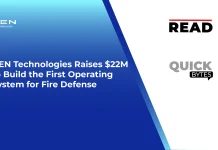STMicroelectronics launched the ISM6HG256X. This three-in-one motion sensor is made for data-hungry industrial IoT applications. The device combines simultaneous, independent accelerometer measurements in both low-g (±16 g) and high-g (±256 g) ranges, along with a precision gyroscope, all within a compact package rated for harsh industrial environments. Equipped with in-sensor edge AI capabilities, the IMU (inertial measurement unit) enables real-time event detection and context-adaptive sensing with ultra-low power consumption-addressing the need for smarter, more autonomous sensing in industrial settings.
What’s New: The Sensor’s Key Features
-
The ISM6HG256X enables dual-range acceleration detection-both ±16 g and ±256 g-thus capturing everything from subtle motion and vibration to severe shocks and impacts, without needing multiple separate sensors.
-
It includes an integrated high-performance gyroscope, enabling angular-rate measurement and 3D orientation tracking-all in a 2.5 × 3 mm surface-mount package, rated for industrial temperatures between -40 °C to 105 °C.
-
Embedded edge-AI processing is built into the sensor-using a machine-learning core (MLC), finite-state machine (FSM), adaptive self-configuration (ASC) and ST’s sensor-fusion-low-power (SFLP) algorithm. These enable classification of events directly inside the sensor, reducing the need for external processing and lowering latency and power consumption.
-
The device targets industrial IoT applications-for asset tracking, worker-safety wearables, condition monitoring, robotics, factory automation and “black box” event recording. By integrating dual-range sensing plus edge AI, ST claims system-design simplification, lower complexity and power savings.
Impact on the Semiconductors & Electronics Industry
This launch is more than just a component update-it reflects deeper shifts in the semiconductors and electronics landscape:
1. Increasing Intelligence at the Sensor Level
Rather than raw MEMS chips simply outputting data, the integration of edge-AI into the IMU means that sensing + computation are moving together into one device. This trend transforms the role of semiconductors-from passive components to intelligent nodes that reduce system decisions to the edge. Designers now expect sensors that not only detect but interpret.
2. Consolidation of Multiple Ranges in One Chip
Traditionally, engineers would use one sensor for low-g motions (vibration, tilt) and another for high-g shocks (impacts, events). The ISM6HG256X does both-reducing bill of materials (BOM), complexity and design cycles. That kind of integration is becoming increasingly valued in electronics design, especially for industrial use cases requiring ruggedness and precision.
Also Read: Rolls‑Royce and Forsee Power Partners to Accelerate Electrification
3. Industrial-Grade Reliability and Longevity
The sensor is rated for extreme environments and includes a long-term availability promise-a requirement for industrial and electronics applications where product lifetimes stretch many years. ST’s focus on longevity supports the electronics industry’s push towards sustainable and dependable component supply chains.
4. Growth in Edge AI and IIoT Demand
As more electronics systems move toward the Industrial Internet of Things (IIoT), they demand components that can handle real-time analytics, event detection and autonomous operation. Semiconductors that embed such capabilities are poised to capture enhanced value. ST’s technology is squarely aligned with that shift.
What It Means for Businesses in This Ecosystem
For semiconductor manufacturers, electronics designers, industrial-system integrators and OEMs, this announcement signals several operational and strategic opportunities and considerations:
Opportunities:
-
OEMs and system integrators can build smarter industrial devices (wearables, trackers, robots, automation systems) using fewer sensor components, resulting in lower cost, size and power consumption.
-
Component manufacturers that embed edge intelligence into chips can differentiate their offerings, address higher value segments and capture more of the system stack rather than simply supplying “dumb” sensors.
-
Electronics firms focusing on Industry 4.0/5.0 can now use advanced sensor nodes. These nodes allow for deeper analytics, improved situational awareness, and autonomous features. Best of all, they don’t need to depend much on the cloud.
Considerations and Challenges:
-
Data and integration complexity: While the sensor can classify events, downstream system design must support how that data is consumed-firmwares, frameworks, AI models and edge-software all matter.
-
Supply-chain and ecosystem alignment: Electronics firms must align sensor selection with their software tools and developer boards. ST provides expansion boards and software libraries for this. Also, they need to ensure long-term support.
-
Competition and cost pressure: As sensors become smarter, cost expectations rise. Businesses must assess whether these advanced features deliver sufficient value for their specific application context.
-
Security and standards: Increased intelligence at sensor level raises questions around edge security, firmware updates, data integrity and interoperability-especially in industrial electronics settings.
Looking Ahead
To stay ahead, companies in semiconductors & electronics should:
-
Focus on sensors with built-in analytics and dual-range features for IIoT. This simplifies systems and enhances event data quality.
-
Review sensor design: assess the balance of intelligence in-sensor versus in-system. Consider power, latency, cost, and reliability trade-offs.
-
Partner for ecosystem readiness: use tools, libraries, and evaluation boards from ST. This helps you speed up your time-to-market.
-
Think about lifecycle and sustainability: long-term availability and environmental durability will matter as electronic systems stay in use for years.
Monitor edge-AI trend: the rise of sensors that process data locally will shape electronics design-expect the “sensor” to become a decision point, not just a data point.
Conclusion
STMicroelectronics’ launch of the ISM6HG256X dual-range motion sensor marks more than a new product-it signifies how semiconductor components are evolving to support smarter electronics systems. The semiconductors and electronics industry is shifting toward several key trends. These include embedded edge AI, range consolidation, industrial-grade durability, and simpler systems. This focus highlights the future of smart devices. These technologies help businesses in this ecosystem. They create smarter, leaner, and more independent solutions. This way, they can stay ahead as intelligence shifts to the edge, not just the cloud.




